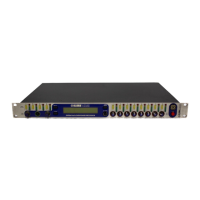
Do you have a question about the Klark Teknik DN9848 and is the answer not in the manual?
| Brand | Klark Teknik |
|---|---|
| Model | DN9848 |
| Category | Computer Hardware |
| Language | English |
Warnings about hazards like fire, electric shock, and moisture.
Guidelines for safe placement and ventilation to prevent overheating.
Precautions against electrical shock, fire hazards, and proper usage.
Advice on location, cables, and electrical fields for optimal performance.
Instructions for inspecting the unit and retaining original packaging.
General introduction to the DN9848 digital electronic cross-over/loudspeaker management system.
Details on parametric EQ, delay, gain, and compression for each input channel.
Details on filters, EQ, delay, gain, compression, and phase correction for each output.
Detailed explanation of the front panel layout, buttons, display, and controls.
Explanation of rear panel connections for power, communications, and audio I/O.
Overview of how to set parameters via the programming panel and encoders.
Details on the display layout and the function of DATA ENTRY encoder knobs.
Guide to moving between Input, Output, and Set Up menus using buttons.
Accessing and using global parameters like comms channel and security.
How to access and use the store and recall functions for settings.
Description of the default display and its dual function for Home/Set Up access.
Overview of signal path including delay, gain, EQ, and compressor stages.
How to configure parameters for each input channel.
Accessing and stepping through input channel menu pages.
Allocating custom names up to 7 characters for input channels.
Setting input gain (-40dB to +12dB) and delay (0 to 1ms/1s).
Using 12 parametric EQ stages for room/venue compensation.
Configuring input channel compressors with variable ratio, knee, attack, and release.
Using 9-segment meters for signal clipping, headroom, and gain reduction.
Overview of signal routing and processing blocks for output channels.
How to configure parameters for each output channel.
Allocating custom names up to 8 characters for output channels.
Selecting signal sources for each output from inputs A, B, C, D, or combinations.
Adjusting phase invert, delay (0-300ms), and baseline output level.
Using all-pass filters for phase alignment at crossover or with PEQs.
Options for HPF/LPF including Butterworth, Linkwitz-Riley, and Bessel types.
Using six parametric EQ stages for output signal equalization.
Configuring output channel compressors for dynamics and loudspeaker protection.
Using a look-ahead limiter to prevent clip and protect equipment.
Using 11-segment meters for output clipping and level monitoring.
Using rotary controls for output level adjustment and muting.
Overview of available set up options for adapting the unit's operation.
Specifying the communications channel for remote control setup.
Options for protecting settings from tampering via passwords.
Setting passwords to lock front panel controls at different security levels.
Limiting operational control to protect against unauthorized tampering.
Adjusting the alphanumeric display contrast for off-axis viewing.
Assigning names to the unit and working memory for identification.
Setting units of measurement for delay (time, metric, imperial).
Configuring logo display and output level ramp on startup.
Procedures for saving current configurations to memory locations.
Steps to retrieve previously saved configurations from memory.
Guide to setting up a daisy-chain network for controlling multiple units.
Information on required cables and converters for PC connection.
Steps to switch from remote control back to manual front panel operation.
Explanation of the benefits of the look-ahead limiter for transient protection.
Further details on how the look-ahead limiter enhances speaker protection and system efficiency.
Using all-pass filters to fine-tune phase response for accurate acoustic alignment.
Detailed explanation and graphs of the all-pass filters for phase shaping.
Specifications for the four balanced analogue input channels.
Specifications for the eight balanced analogue output channels.
Technical performance metrics like frequency response and distortion.
Specifications for gain, delay, and parametric EQ on input channels.
Specifications for routing, phase, gain, delay, and filters on output channels.
Available types, frequency range, and boost for HPF.
Available types, frequency range for LPF.
Specifications for parametric EQ frequency range, boost/cut, and bandwidth.
Specifications for compressor threshold, attack, release, ratio, and knee.
Specifications for limiter threshold, release, and knee.
Voltage, consumption, and fuse rating for the unit.
Physical dimensions and weight of the DN9848.
Connector types for audio, comms, RS-232, and power.
